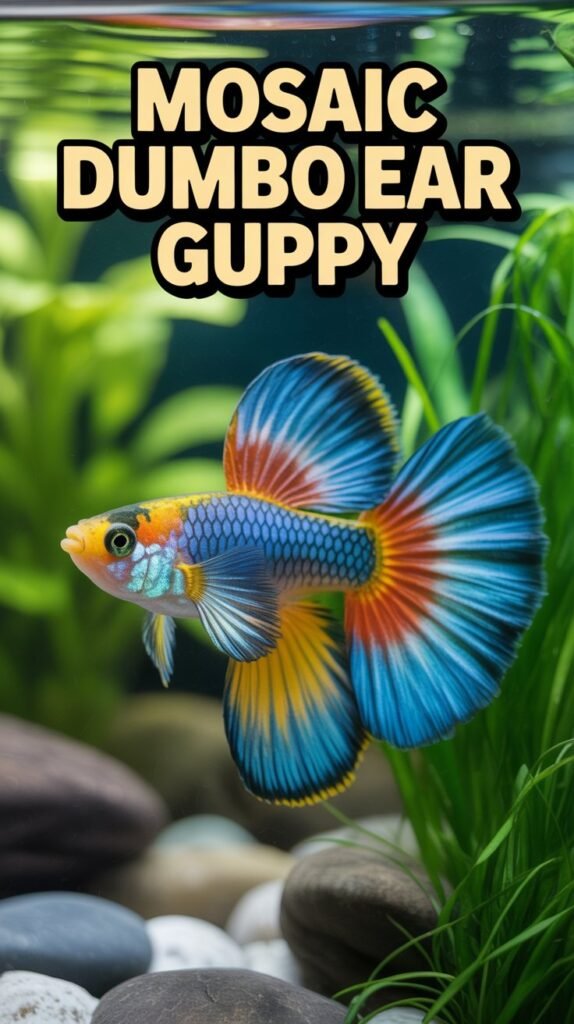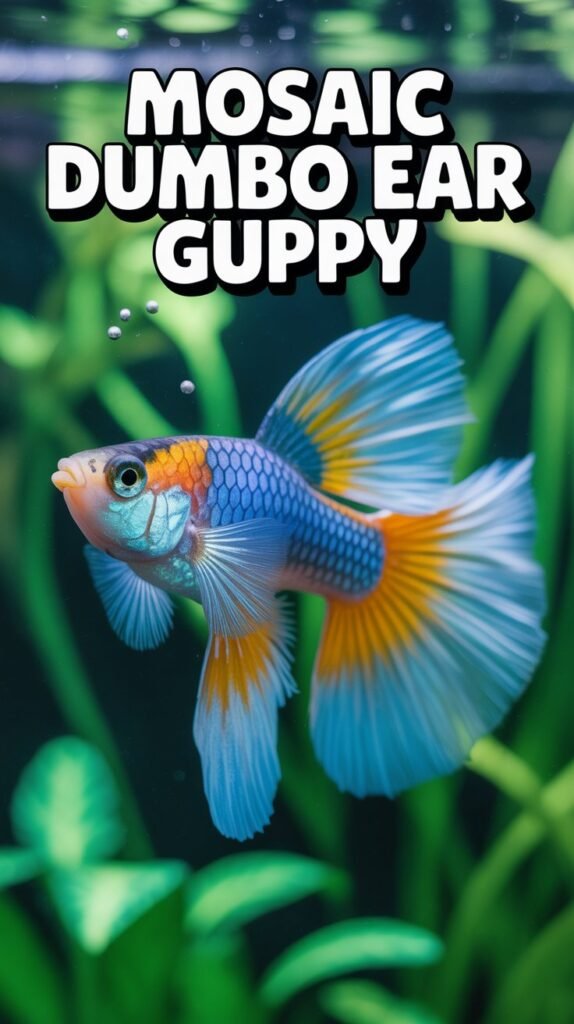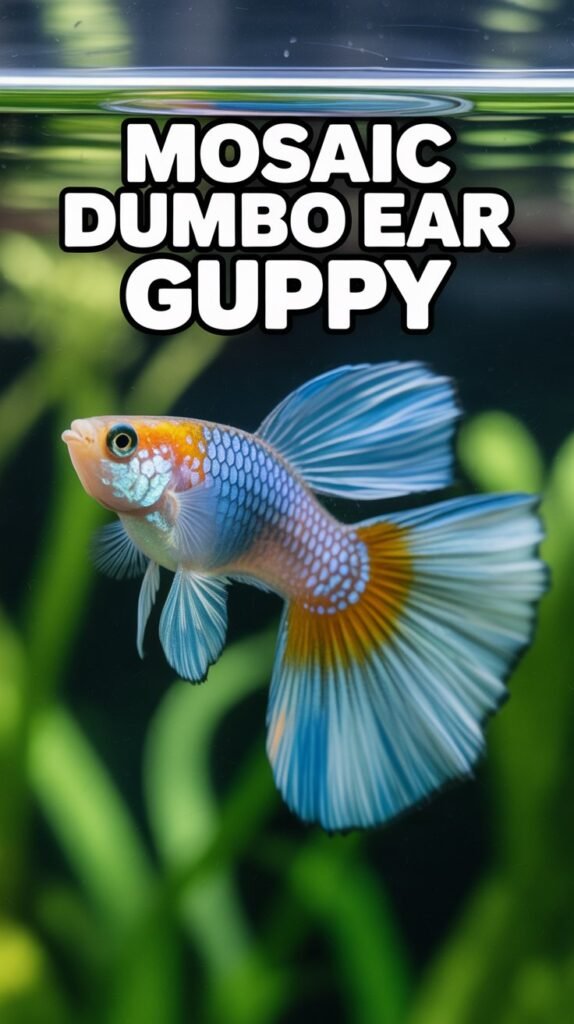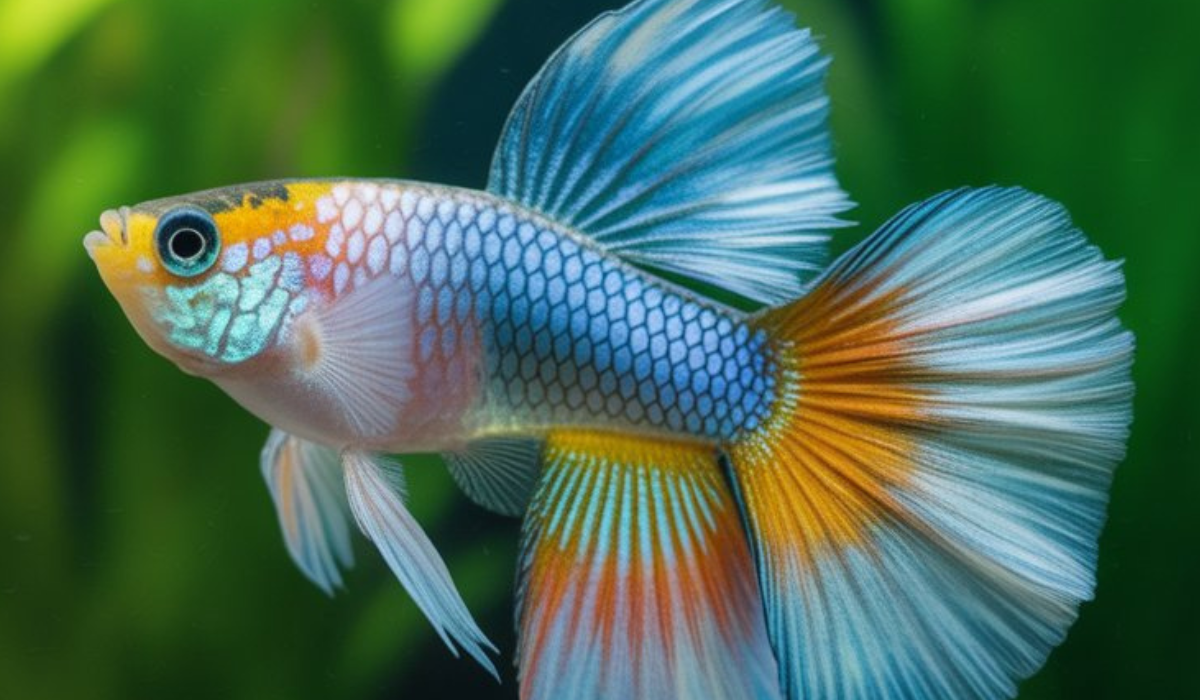Among the most breathtaking and elegant aquarium fish, the Mosaic Dumbo Ear Guppy stands out for its dazzling coloration and distinctive fin structure. Known for its large, ear-like pectoral fins and intricate mosaic tail pattern, this guppy variety is a favorite among aquarists worldwide. Whether you are an experienced hobbyist or a beginner in fishkeeping, the Mosaic Dumbo Ear Guppy adds beauty, personality, and life to any aquarium setup.
In this guide, we will explore everything about the Mosaic Dumbo Ear Guppy — from its origin and physical appearance to care, diet, breeding, and ideal tank conditions. By the end of this article, you’ll have a thorough understanding of how to keep these fascinating fish healthy and thriving.
Origin and Background
The Mosaic Dumbo Ear Guppy belongs to the species Poecilia reticulata, commonly known as the guppy or millionfish. Native to the freshwater streams of South America — primarily in Venezuela, Guyana, and Trinidad — guppies have been selectively bred for decades to enhance their colors, patterns, and fin types.
The “Mosaic” term refers to the tail pattern, which displays a network of interlocking spots resembling a mosaic artwork. The “Dumbo Ear” name is inspired by their enlarged pectoral fins that fan out like the ears of the famous Disney elephant, Dumbo. When combined, these traits create a fish that is both visually striking and graceful in movement.

Through selective breeding in Asian guppy farms, the Mosaic Dumbo Ear Guppy was developed to highlight its vivid coloration, tail patterns, and elegant fin extensions. It has since become a prized variety among guppy enthusiasts and competitive breeders.
Physical Appearance
The Mosaic Dumbo Ear Guppy is one of the most eye-catching ornamental fish in the guppy family. Several physical traits make this variety distinct:
1. Pectoral Fins
The Dumbo Ear Guppy’s most defining feature is its oversized pectoral fins. These fins resemble wings or large ears, gracefully flapping as the fish swims. They can be translucent, metallic, or colored, depending on the breeding line.
2. Tail Pattern
The “Mosaic” tail pattern displays a mix of interconnected dots or patches in contrasting colors such as red, blue, orange, and black. The tail fin often has a wide and flowing shape, adding elegance to the fish’s movement.
3. Body Coloration
Mosaic Dumbo Ear Guppies come in a variety of colors. Common combinations include:
- Blue mosaic
- Red mosaic
- Purple mosaic
- Multicolor variants with iridescent highlights
The body usually shines with metallic undertones, creating a luminous effect under aquarium lighting.
4. Size
Adult males typically grow up to 1.5–2 inches, while females can reach 2.5–3 inches in length. Despite their small size, their vivid fins make them appear larger and more elegant.
Behavior and Temperament
Like most guppies, the Mosaic Dumbo Ear Guppy is peaceful, active, and social. They thrive in community tanks and get along well with other small, non-aggressive fish. Males are playful and often display their fins to attract females, while females are calm and steady swimmers.
However, males can be persistent during mating seasons, so maintaining a proper male-to-female ratio (1 male for every 2–3 females) helps reduce stress among the fish. They are also curious and love exploring plants, decorations, and hiding spots within the tank.
Tank Requirements
Providing the right environment ensures your Mosaic Dumbo Ear Guppy remains healthy and vibrant. Below are the ideal tank setup and parameters for keeping them happy.
1. Tank Size
A minimum 10-gallon tank is recommended for a small group. However, a 20-gallon or larger aquarium is ideal for maintaining a healthy colony and ensuring stable water conditions.
2. Water Parameters
- Temperature: 75°F – 82°F (24°C – 28°C)
- pH Level: 6.8 – 7.8
- Water Hardness: 8 – 12 dGH
- Ammonia/Nitrite: 0 ppm
- Nitrate: Below 20 ppm
Guppies thrive in slightly alkaline and moderately hard water. Maintaining consistent parameters prevents stress and disease.
3. Filtration
Use a gentle sponge or internal filter to ensure clean water without creating excessive current. Dumbo Ear Guppies have large fins that can be damaged by strong water flow.
4. Lighting
Moderate to bright lighting enhances the iridescence of their fins. LED aquarium lights work best for displaying their colors.
5. Aquascaping
Decorate the tank with live plants like Java moss, Anubias, and Hornwort. These provide hiding spots and help absorb toxins. Smooth rocks, driftwood, and gentle substrates complete a natural-looking setup.
Diet and Nutrition

Mosaic Dumbo Ear Guppies are omnivorous and require a balanced diet for optimal health and color development. In captivity, they thrive on a mix of dry, frozen, and live foods.
Recommended Foods
- High-quality flakes or pellets: Specially formulated guppy or tropical fish flakes.
- Live foods: Brine shrimp, daphnia, bloodworms, and mosquito larvae.
- Frozen or freeze-dried foods: Excellent protein sources that mimic natural feeding.
- Vegetable matter: Blanched spinach, spirulina flakes, or zucchini slices.
Feed them 2–3 times daily in small portions they can consume within two minutes. Overfeeding can lead to bloating and water quality issues.
Tankmates
The Mosaic Dumbo Ear Guppy is best kept with peaceful community fish that share similar water preferences. Avoid aggressive or fin-nipping species that may damage their delicate fins.
Ideal Tankmates
- Endler Guppies
- Neon Tetras
- Corydoras Catfish
- Mollies
- Platies
- Harlequin Rasboras
- Shrimp and Snails
Tankmates to Avoid
- Tiger Barbs
- Betta Fish (especially males)
- Large Cichlids
- Red-tailed Sharks
Selecting compatible tankmates ensures a harmonious environment where your guppies can display their natural behavior freely.
Breeding Mosaic Dumbo Ear Guppies
One of the joys of keeping guppies is how easily they breed. Mosaic Dumbo Ear Guppies are livebearers, meaning females give birth to free-swimming fry instead of laying eggs.
1. Breeding Setup
Set up a separate breeding tank (10 gallons) with gentle filtration, stable temperature (around 78°F), and dense plants like Java moss for fry to hide in.
2. Selecting Breeding Pairs
Choose healthy, mature fish with vibrant colors and large fins. A ratio of one male to two or three females prevents stress and ensures successful mating.
3. Mating Process
The male courts the female by spreading his fins and performing a dance. Fertilization occurs internally, and the gestation period lasts 21–30 days, depending on temperature and diet.
4. Birth and Fry Care
A single female can give birth to 30–80 fry. After birth, remove the mother to prevent her from eating the fry. Feed the newborns with infusoria, baby brine shrimp, or crushed flakes several times daily.
5. Growing Fry
Fry grow quickly under proper care and can start displaying colors within 4–6 weeks. Maintain clean water and stable temperatures for healthy development.
Common Diseases and Health Issues
Although generally hardy, Mosaic Dumbo Ear Guppies are susceptible to certain aquarium diseases, especially under poor conditions. Below are some common problems and how to prevent them.
1. Ich (White Spot Disease)
Symptoms: White spots, rubbing against objects, lethargy.
Prevention: Maintain stable water temperature and quarantine new fish.
Treatment: Gradually raise temperature to 82°F and use an Ich treatment.
2. Fin Rot
Symptoms: Frayed or discolored fins.
Prevention: Maintain clean water and avoid aggressive tankmates.
Treatment: Use antibacterial medication and improve tank hygiene.
3. Swim Bladder Disorder
Symptoms: Difficulty swimming or floating sideways.
Prevention: Avoid overfeeding and provide varied diet.
Treatment: Fast the fish for a day or two, then feed boiled peas (skinned).
4. Fungal Infections
Symptoms: Cotton-like patches on the body.
Prevention: Quarantine new fish and keep tank clean.
Treatment: Use antifungal aquarium medication.
Proper care, balanced diet, and regular water changes go a long way in keeping these guppies disease-free.
Color Enhancement Tips

If you want your Mosaic Dumbo Ear Guppies to display their brightest and most vivid colors, follow these tips:
- Feed Color-Enhancing Foods: Include carotenoid-rich foods like spirulina and shrimp.
- Provide Proper Lighting: LED lighting enhances color intensity.
- Stable Environment: Avoid frequent water parameter fluctuations.
- Genetic Selection: Breed from the most colorful and healthy parents.
- Stress-Free Tank: Avoid overcrowding and aggressive fish.
Why Choose Mosaic Dumbo Ear Guppies?
There are several reasons aquarists love Mosaic Dumbo Ear Guppies:
- Aesthetic Beauty: Their fins and tail patterns make them living works of art.
- Active and Peaceful Nature: They are lively yet calm, perfect for community aquariums.
- Easy to Breed: Suitable for beginners interested in fish breeding.
- Hardy and Adaptable: They tolerate a wide range of water conditions.
- Educational Value: Great for learning genetics, as guppy offspring show diverse color patterns.
Maintenance and Care Tips
To keep your Mosaic Dumbo Ear Guppy healthy and happy, follow these maintenance practices:
- Perform 25–30% water changes weekly to maintain water quality.
- Use a reliable heater and thermometer to ensure temperature stability.
- Regularly clean the filter and tank decorations.
- Observe your fish daily for signs of stress or disease.
- Avoid overcrowding; a good rule is 1 inch of fish per gallon of water.
Consistency is key — a clean and stable environment ensures your guppies live longer and display their best colors
Lifespan
With proper care, Mosaic Dumbo Ear Guppies live an average of 2 to 3 years. Maintaining ideal water conditions, offering high-quality food, and preventing disease can extend their lifespan even further.
Conclusion
The Mosaic Dumbo Ear Guppy is truly a jewel of the aquarium world. Its combination of stunning mosaic patterns, large ear-like fins, and friendly personality make it an irresistible addition to any tank. Easy to care for, breed, and admire, this guppy variety embodies both beauty and resilience.
Whether you are a beginner or a seasoned aquarist, keeping Mosaic Dumbo Ear Guppies promises endless enjoyment and a visually captivating aquarium experience.
FAQs About Mosaic Dumbo Ear Guppy
Q1. What is the ideal temperature for Mosaic Dumbo Ear Guppies?
The ideal water temperature ranges from 75°F to 82°F (24°C to 28°C) for optimal health and color vibrancy.
Q2. How can I differentiate male and female Mosaic Dumbo Ear Guppies?
Males are smaller, more colorful, and have larger fins. Females are larger and have rounder bodies with a visible gravid spot near the abdomen.
Q3. Are Mosaic Dumbo Ear Guppies suitable for beginners?
Yes, they are hardy and easy to care for, making them an excellent choice for beginners.
Q4. What should I feed my Mosaic Dumbo Ear Guppies?
Feed them a mix of high-quality flakes, live foods (like brine shrimp), and vegetable matter to maintain health and color.
Q5. How often do Mosaic Dumbo Ear Guppies breed?
Females can give birth approximately every 4–6 weeks, depending on water conditions and temperature.
Q6. Can I keep Mosaic Dumbo Ear Guppies with Betta fish?
It’s not recommended, as Bettas can be territorial and may nip at the guppies’ fins.
Q7. What is the lifespan of a Mosaic Dumbo Ear Guppy?
With proper care, they live around 2 to 3 years, though some may live longer in optimal conditions.
Q8. How many Mosaic Dumbo Ear Guppies should be kept together?
Keep at least a group of 6, ideally with more females than males to maintain social balance.
Q9. How do I enhance the colors of my Mosaic Dumbo Ear Guppies?
Provide a nutritious diet, proper lighting, and stress-free conditions to bring out their full coloration.
Q10. Are Mosaic Dumbo Ear Guppies aggressive?
No, they are peaceful and get along well with other community fish of similar size and temperament.

